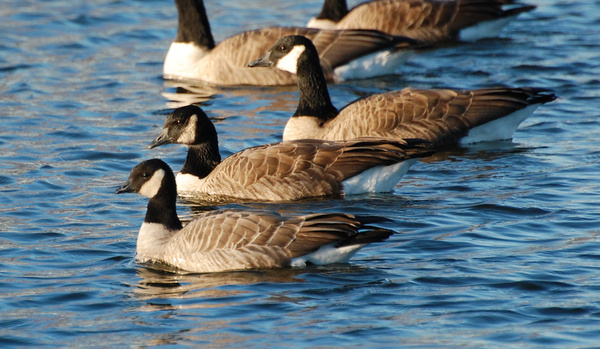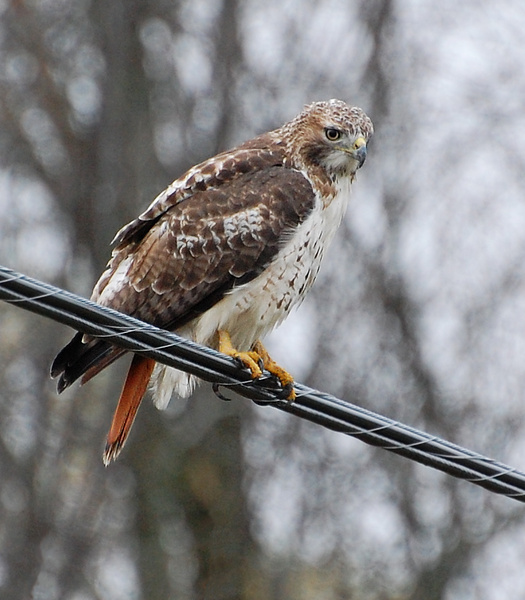
Life bird #318
November 13th, 2012
The fellow second from the front is my latest lifer, and a long time coming! This small, stubby-billed Canada-Goose-lookalike is a Cackling Goose, a bird of the far north.

Photos of Cackling Geese are often framed to emphasize their tininess--placing them in the backdrop, for instance, or placing them right next to a "Giant" Canada Goose (the familiar large, long-necked subspecies that frequents our local parks in summer, often with goslings in tow.) I'm as guilty of this as anyone (see above!) But I feel it does novice birders a disservice. Cackling Geese, at least in the east, are not that small compared to smaller races of the Canada Goose, with whom they are often seen. It's the stubby bill that really gives them away, in my opinion. A somewhat fairer comparison shot follows (Cackling Goose in front):

Exploring the Lime Kiln burn
November 6th, 2012
I went back to the Lime Kiln burn site, and this time, the female Black-Backed Woodpecker was willing to pose for the camera! (See here to read the background and to learn all about this unique woodpecker.)

She's a somber bird, designed to blend in with the ashen-hued colors of a burned forest. But she does show a pretty blue sheen on her back feathers in good light.

Chickadees followed me into the burned woods, hoping for a handout. I was amused by how baleful their charred surroundings made them look.

1680x1050 wallpaper
"You will give us seed. You will give us seed now."
( More baleful chickadees )
Hairy Woodpecker portrait
November 4th, 2012

A photogenic hawk
November 1st, 2012
This rather tame Red-Tailed Hawk has been seen frequently along Carling Ave., and attracted a lot of photographer attention. Even when several people are up close, he blithely ignores them while scanning the ground below for scurrying field mice. He haunted the same stretch of road last winter, as a juvenile, now, with his mature brick-red tail feathers grown in, he's even more fun to photograph.

1680x1050 wallpaper
Snow Buntings at Shirley's Bay
October 29th, 2012
A flock of Snow Buntings has been lingering at the Shirley's Bay boat launch area for the last little while. These are sparrow-like, arctic-breeding songbirds, that winter on open land throughout much of the U.S. and Canada. I find them adorable. I also find them elusive! Prior to yesterday, I had never seen Snow Buntings within the city limits of Ottawa (outlying rural areas like St. Isadore are generally a better bet), nor had the opportunity to photograph them.
Snow Buntings are masters of camouflage. Their winter plumage is a mix of white, black, and orangey-brown, perfectly designed to blend in with the colors of a snowed-over field. Yesterday I learned that their camouflage is equally effective on rocky river shores. Repeatedly I was amazed to see the flock--briefly flushed--settle down a short distance from me and utterly melt into the landscape. Even on bare rock.
With this fellow, I stalked up close and carefully timed my shot, and sharpened and contrast-enhanced it, to make him stand out as much as possible. (Note nonetheless how all his colors are shared by the surrounding landscape, with the exception of the brighter whites as there hasn't been snow yet.)

And with this photo I didn't do any of those things. Quick, where's Waldo?

( More pix )
Autumn At Andrew Haydon Park
October 25th, 2012
There were dark clouds on one side of the sky and full sunlight on the other. It made for spectacular lighting.

1680x1050 wallpaper
An odd duck, and the upside of forest fires
October 23rd, 2012
I had read on Ontbirds that a super-rare female Tufted Duck was being seen at Shirley's Bay. This is a Eurasian species that has only strayed into our area once before in recorded history. So I headed down to the boat launch parking lot, joined a large group of birders with scopes, and had a look. Success!
Of my three lifers yesterday, this is one I kind of have to call a technicality. The female Tufted Duck doesn't share the male's obvious strange hairstyle. The only thing to distinguish her from her new-world counterpart (Ring-Necked Duck) is a teeny little nub of feathers on the back of the head. I saw the duck, and I saw the teeny nub. But no way by myself would I even have noticed, much less thought it significant, much, much less confidently identified her on the basis of it!
Bob Cermak, one of the local experts, was there. As I was about to leave, I overheard him tell someone that a Black-Backed Woodpecker had been reported at Lime Kiln Trail, and my ears perked way up. Black-Backed is one of the two boreal woodpeckers that are seldom seen in Ottawa, and had never been seen by me. So I immediately hopped in my car and zipped over there, where I intersected with Bob's group and ended up falling in with them.
There was a forest fire at Lime Kiln Trail earlier this year. A forest fire is generally seen as an unfortunate thing. But for certain birds, and for the birding world, it's actually a big positive. Birds, like other creatures, evolved in the presence of natural fires. They have ways of dealing with it. Some have even evolved to specialize in burned-over areas, for various reasons--maybe because they like the resulting open habitat, or because they prefer to dig their nest holes in burnt trees, or because their preferred insect prey specialize in burns. Naturalists call them "fire followers."
A lot of those birds are in trouble now. Unfortunately evolution is blind, and didn't know that humans were going to come along and devastate the "fire follower" niche. Fire prevention policies have even driven a few species to near-extinction. (The tide is now being turned in some cases via the use of prescribed burns.) Burn sites are at a premium, so when a new one appears, it's a given that interesting birds will show up there. An old burn site in Constance Bay, for instance, is Ottawa's only known location for breeding Red-Headed Woodpeckers: a single pair of them. Lime Kiln Trail, or at least part of it, is now such a site, and assuming the city leaves it more or less alone, it could remain so for years.
The Black-Backed Woodpecker report was recent and news to all of us, but as we explored the site, it became clear that the species had been there for months, and probably more than one of them. The telltale sign of boreal woodpeckers is bark stripped off of dead trees. They eat a special kind of beetle larvae that tunnel under the bark. There were trees in those woods that had been more than half de-barked. Trees with heaps of bark piled under them.
I wasn't the only one who was kicking myself that I hadn't thought of it sooner. I knew about fire followers. And I had been planning on going there in spring, searching for Red-Headed Woodpeckers, Olive-Sided Flycatchers and others. It just didn't occur to me to do it in fall.
So we fanned out over the burn site, pored over every promising tree, listened carefully for the sound of slow tapping, and came up empty. Tons of Downy and Hairy Woodpeckers, the most I've ever seen in one place (clearly burn sites are of interest even to some birds that don't specialize in them per se), but no Black-Backed.
Damned if I was giving up. I went home, had lunch, showered, and went back out solo. This time I found it! Specifically her--a female. Which proves that there is at least a pair, since the original report was of a male. Have they bred? Will they breed? I can't wait to find out.
I have no pictures as yet, since she flew off before I got the chance to close in on her. But I'll be back to try again.
ETA: Success, photos here!
This autumn has been like magic. So many surprises. This afternoon, twenty-four Sandhill Cranes were circling on thermals practically right over my house. I wonder what else it has in store?
A day of jawdrops
October 22nd, 2012
Little did I know, waking up this morning in a foul mood, that it was going to be a three-lifer day and my mood was going to get entirely turned on its head.
One lifer was this little guy:

A Northern Saw-Whet Owl. And I do mean little. At 7-8 inches tall, shorter than a red-winged blackbird, this is the smallest owl in eastern North America. (Smaller ones still occur out west, including the ~5 inch Elf Owl that nests in cactuses.) For comparison, the common Great Horned Owl is up to two feet tall.
I was searching for this bird, having heard about him from another birder on the trail. I have chickadees to thank for finding him. You've probably heard the chickadee-dee-dee call before. When there are only a few "dees" to a "chick", it's just a standard "heads up" that can be used for any number of reasons (including "hey, a human is here. Lets see if she'll feed us.") But when you hear something more like "chickadee-dee-dee-dee-dee-dee-dee", it means there's a raptor around. A recent study showed that the more dees there are, the more threatened the chickadee feels. A small raptor like a Saw-Whet Owl, just the right size for catching and eating a tiny chickadee, is a major threat indeed. So when I heard a "chick" followed by ten "dees", I figured I was getting warm.
I've read that when chickadees make these calls, it's a call to arms. They're inviting other chickadees to join forces, mob the raptor and drive it away. (If the raptor is currently in flight and thus a present danger, the calls are different: very high pitched peeps that mean "lay low, guys.") But I'd never seen this in action before. I'd seen crows mob, blue jays mob, but I'd never seen chickadees do anything more than make noise. Until now. Suddenly the calls became louder, faster, more insistent--like a chickadee war whoop--and then they converged on a tree and started hopping up through the branches. I looked up to where they seemed to be headed, and there he was, sleeping away! He blinked groggily as the chickadees surrounded and fussed at him, then nodded off again. I would have liked to get a shot of him with his cute googly eyes wide open, but was unwilling to disturb his sleep to do it.
Unfortunately, owls at known roosts face a lot of harassment from unscrupulous photographers. For this reason I'm not publicizing the location.
Continued in next post!
Indian summer
October 18th, 2012
In a matter of a few days, we went from flurries to t-shirt weather! And guess who came out to bask in the sun?

1680x1050 wallpaper
Diners at Shirley's Bay
October 12th, 2012
A few recent customers at the Shirley's Bay feeders on Hilda Road.

1680x1050 wallpaper
White-Crowned Sparrows are migrating through right now. I think they are one of North America's most handsome sparrows. We only see them in Ottawa in spring and fall--they breed well north of us.

"Seriously, this is it? This is the famous Shirley's Bay bird smorgasbord?"

"Oh...you mean this was for the birds?"
( More (White-Breasted Nuthatch, White-Throated Sparrow) )
|
